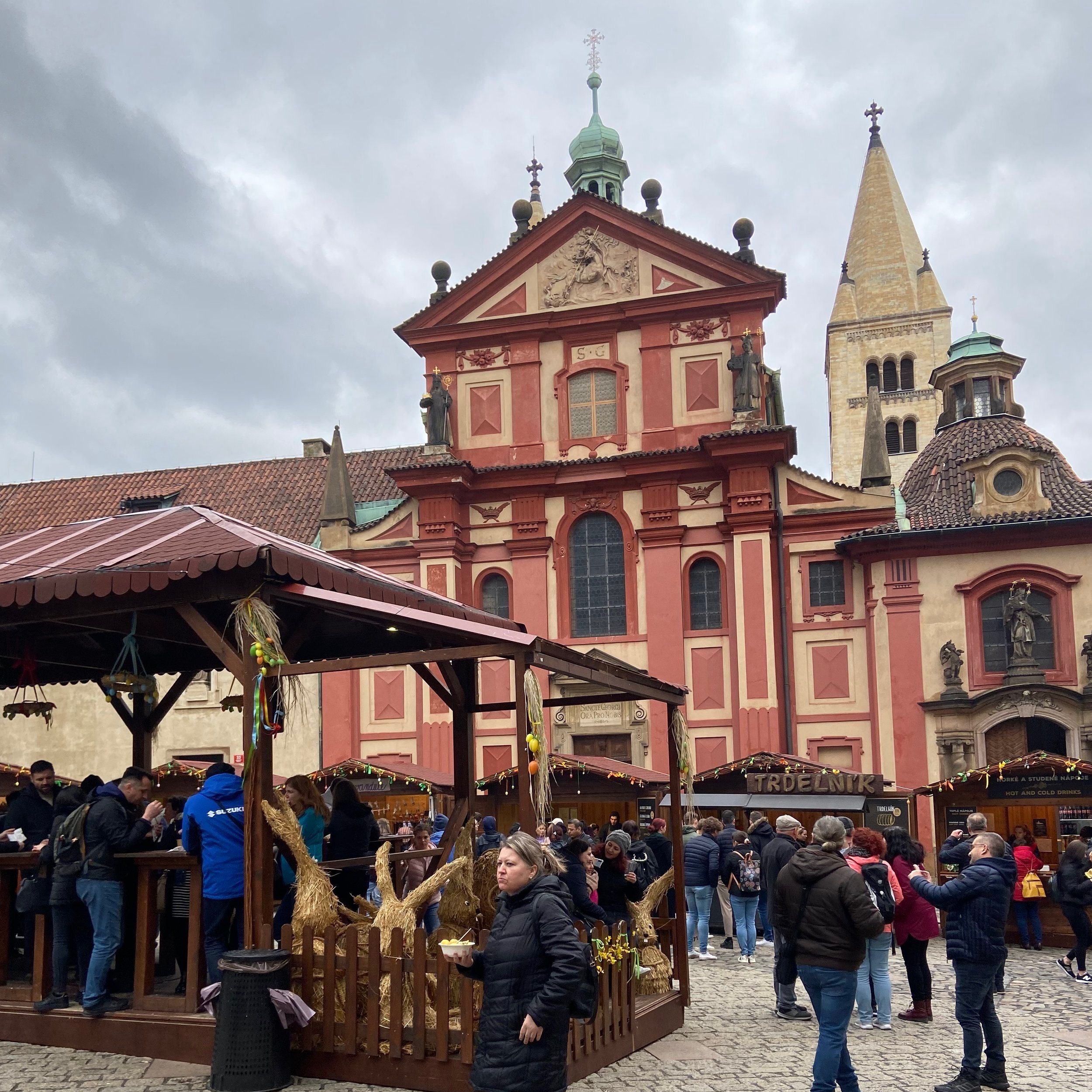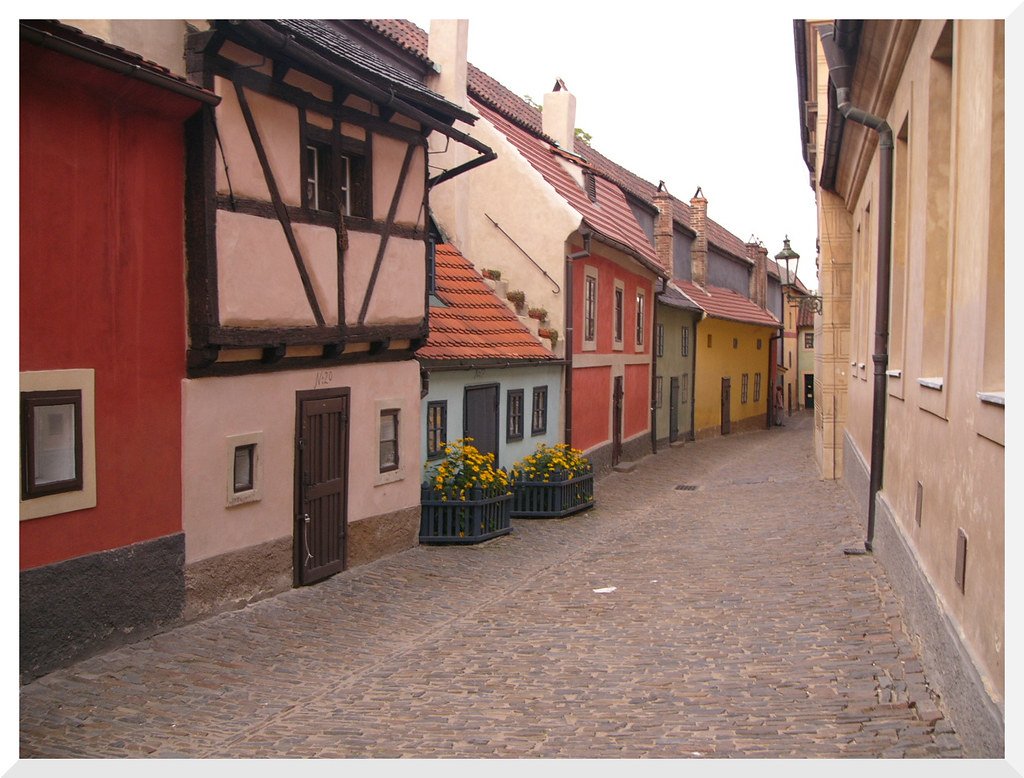Road Trip: Prague
Prague is magical! It is so much like a fairytale, I can’t wait to go back. We stayed near the castle in an old bed & breakfast, full of charm, that used to be horse stables. Just a few steps out the door and we had the best views over the city with all of the spires and European charm you expect.
We walked across the Charles Bridge with the biggest smiles on our faces…it just all felt like a pinch-me-moment. This bridge is the most famous bridge in Prague and connects the city’s Old Town to the Mala Strana over the Vltava River. Supposedly the bridge, which was built all the way back in the 1300s, is haunted by ghosts whose heads ended up on nearby spikes. People claim that they have seen them wandering up and down Charles Bridge, going about their business as they please. The official inauguration of Charles Bridge was at 5:31 am on July 9th, 1357. King Charles IV was a very superstitious man who believed in astrology and numerology. He erected the bridge following a palindrome – a numerical sequence you can read the same way from both ends – 1-3-5-7-9-7-5-3-1 (year, day, month, time).
There are so many fun facts about Prague that we learned while we were there:
Prague bears the nickname “The City of a Hundred Spires”. It got this name because of the 120+ spires and towers you can find across the city. And these are just the large ones. Many enthusiasts tried to count all spires and towers that dot the city. The total number they ended up with is between 500 and 1,000, excluding the small spires on residential buildings.
The President’s home at Prague Castle.
Prague locals consume the most beer per capita in the entire world. You can have a complete spa experience here with a beer bath, something that many tourists do. It was fun to see so many people enjoying beer in the big glasses with inches of foam on top.
Urban legend says Hitler didn’t want to destroy Prague’s Jewish quarter. In fact, his initial plan was to settle in the capital and turn the Josehof Quarter into a museum, preserving the memory of “the extinguished race”. Hitler didn’t demolish Prague’s Jewish Quarter during World War II because he wanted to retire there.
Europe’s oldest active synagogue is in the Czech capital. The Old-New Synagogue, often called Altneuschul, was one of Prague’s first Gothic buildings. It’s not only the oldest active synagogue in Europe but also the oldest surviving medieval synagogue with a twin-nave design.
Prague’s Astronomical Clock Tower hides a crazy legend. According to it, Old Town councilors blinded Hanus Carolinum, the genius who created the world-famous clock tower. They did that because they feared Carolinum might create a similar clock tower in another city, making Prague’s less unique.
We saw two different wedding parties trying to take pictures on the very busy Saturday that we were here. It was also the last day of the Easter Markets so the crowds were extra!
I’m not really a fan of bratwurst so I got a stick of grilled chicken and peppers that was so good. The holiday market food is always so fun.
Prague has the 3rd largest castle complex in the world with some incredible history. The crown jewels are kept there. Stowed away in a chamber inside St. Vitus Cathedral, the Bohemian Crown Jewels include the St. Wenceslas crown, royal scepter, and coronation cloak. The Republic isn't taking any chances with their safekeeping, either, considering both the chamber door and iron safe inside have seven locks. The keys are held by seven people, including the president, prime minister, and Prague archbishop. Only the president can make the call of how Prague's Bohemian Crown Jewels are displayed publicly. They are typically put on exhibit every five years or so. When this happens, all seven key holders must be present for the unlocking process.
Good King Wenceslas is buried here, and the Crown Jewels are accessed through this chapel.
St. Vitus Cathedral in the castle complex holds the most extensive church treasury in the Czech Republic and among the largest collections in Europe. Some items can be traced back to the early Middle Ages, but one relic, in particular, stands out— the arm of Saint Vitus, a Sicilian who died a martyr when the co-ruling Roman Emperors Diocletian and Maximian cracked down on Christians in 303. Years later, in the Late Middle Ages, people in countries like Germany and Latvia celebrated the feast of Vitus by dancing at his statue. Today, he's known as the patron saint of dancers and entertainers, as well as epileptics. He's also believed to protect against lightning strikes.
The tomb of John Napomuk, aka the most famous person you’ve never heard of. There are 12,000 statues of Napomuk across central and Eastern Europe. Napomuk died in Prague in 1393, and there is a statue of him on the St. Charles Bridge. It’s readily noticeable because he has a crown of 5 stars. John stayed faithful to his role of Catholic priest and refused to reveal things that had been shared with him by the queen during confession. He was arrested, tortured and thrown over the bridge and drown. His story became a legend for both peasants and nobility alike. As a saint, he is said to protect against flooding and drowning, which is why he is often found as a statue near bridges and water.
Famous Prague artist, Alphonse Mucha, painted this window of the cathedral. It was so beautiful in person.
Chimney Cakes were everywhere, all over the city, which means all of Prague smells of fresh sweet bread, and cinnamon and sugar. It was divine!
We were so lucky to see traditional dancing.
Golden Lane, a small street just behind Prague Castle, has charming rows of little houses. These days, tourists mill around and shop for souvenirs and books on some of the lower floors, but in the last years of the 16th century, alchemists under Emperor Rudolf II lived here and reportedly tried to turn metal into gold.
Numerous famous people lived or performed in Prague. Beethoven had two public piano concerts in Prague. Mozart performed at least a few of his operas in the city. Franz Liszt lived in the Czech capital for six years and put on many concerts there. Many other popular Czech composers performed in Prague, too, including Antonнn Dvořбk, Bedřich Smetana, and Leoљ Janбček.
I left Prague happy that it’s only a short drive from where we live because I want to come back with Matt. It was a beautiful place to explore and I am so glad that we went, ate all the foods, and soaked up all the scenery.


























